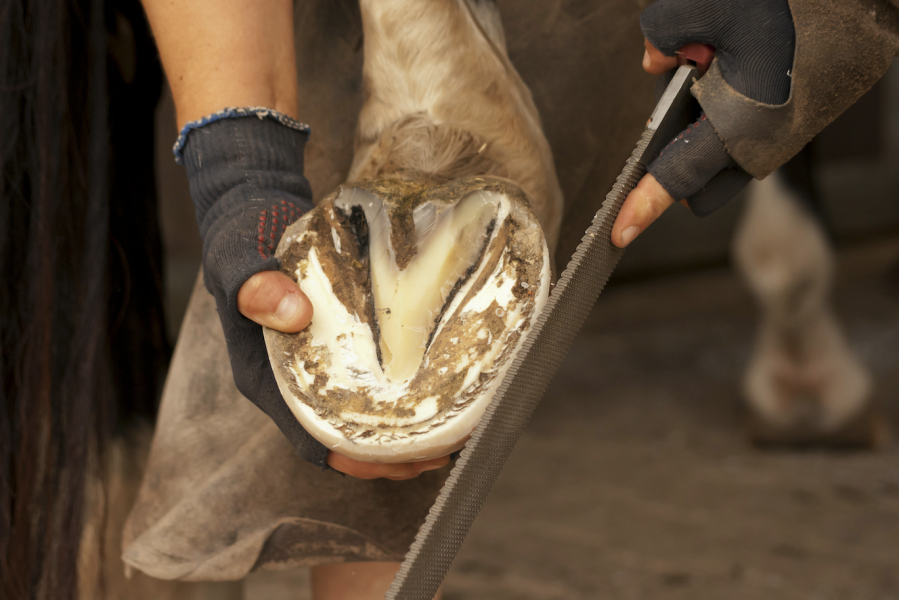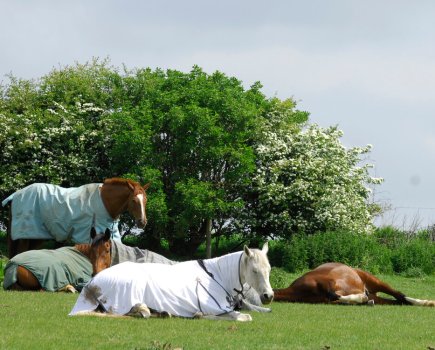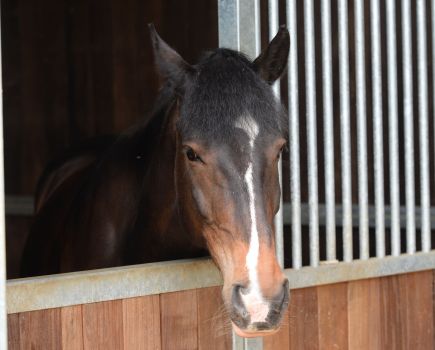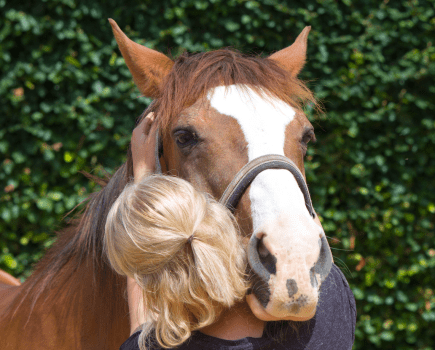Could your horse be better off by being barefoot? Its benefits have long been known yet commonly overlooked when it comes to hoof care. However, a horse that slips less when hacking on a wet road or never comes in from the field minus a shoe (because there aren’t any to lose) is a major selling point — and optional barefoot horse boots can help to make the transition easier.
A 2022 study by Prof Lars Roepstorff and his team from the Swedish University of Agricultural Sciences found that when barefoot the movement of a horse’s hoof widens over the heel, and there is contraction at the heel during the breakover*.
There was also more vertical independent movement in a barefoot hoof, which could contribute to increased blood flow to the leg — important when recovering from an injury.
Prof Lars Roepstorff, working with Swedish showjumper Peder Fredricson and vet Staffan Lidbeck, set out to gain knowledge about when and how it is appropriate to ride horses with shoes or barefoot. Peder has trained and competed at the highest level, including the Tokyo Olympics, with horses who are unshod and has had positive experiences.
In fact, barefoot horses carried Swedish riders to team and individual gold in showjumping at the 2022 FEI World Championships in Denmark.
“I’ve found that [by keeping them] barefoot, the horses are healthier and have fewer injuries, so I think it will be very interesting to show why this is,” said Peder.
(*Breakover is when the very last part of the hoof — the toe — leaves the ground)
Could your horse be barefoot?
So far only preliminary results of the Swedish study have been shared. This first analysis phase was conducted with funding from equine insurer Agria and more results will be announced when they have been analysed. With these early findings being so positive, many owners will be considering whether their own horse could go barefoot — but is barefoot right for every horse?
“There are many advantages to going barefoot,” says Liz Angus, a member of Barefootworks, the UK’s first barefoot trimming practice. “These range from improving the health, shape and quality of your horse’s feet, to less obvious benefits, such as endurance riders noting improved heart rates and recovery times in their barefoot horses, as well as fewer leg injuries caused by concussion.
“Many owners whose horses have struggled with poor hoof health for years often see their horse’s feet change beyond belief when they venture down the barefoot route,” continues Liz.
“As an owner, you’ll probably also find you get much more involved in your horse’s hoof care routine when they are barefoot, noticing things about their hooves that you’ve never considered before, so it can be a great learning curve.
Advantages of horses wearing shoes
The pros of horses being shod include:
- Shoes can counteract the effects of poor conformation and help to keep some horses sound.
- Remedial farriery can assist in managing injuries and conditions such as laminitis and navicular.
- Shoes prevent the horse’s hoof wearing down too quickly when working regularly on hard surfaces.
- Being shod also protects the horse’s soles from bruising.
- Shoes enable horses to wear studs that offer extra grip.
- Horses wearing shoes generally have better grip when ridden on grass (even without studs) compared to one that is barefoot.
Advantages of a barefoot horse
The pros of keeping a horse barefoot include:
- It is more natural for the hoof, which is able to function as nature intended.
- Barefoot allows the hoof to work in a way nature intended.
- The hoof isn’t damaged by nails from shoeing.
- A kick from an unshod horse is less damaging than one from a shod horse.
- It could save money as trimming is generally cheaper than shoeing.
- No more lost shoes!
How to transition a horse to barefoot
When deciding whether your horse should go barefoot, you need to consider whether you have the time to invest in the first few weeks or months of transitioning, and the time it takes varies depending on the individual horse. Some horses may need barefoot horse boots to provide extra protection during exercise initially.
“All horses are capable of being barefoot because, after all, they were born that way. Sometimes, though, their lifestyle is the deciding factor; not all owners are able to keep a barefoot horse and shoes are sometimes necessary to help that horse perform the tasks they’re asked to do,” states Emma Burston, an equine podiatrist specialising in barefoot hoof care.
To prepare your horse for the transition from wearing shoes to being barefoot, undertake some research and find someone you really trust to see you and your horse through the process. Consider the cost too; it may mean more frequent farrier visits at first and investing in a decent pair of barefoot horse boots.
“An equine podiatrist will provide you with an individual plan for your horse at your first appointment which will make the transition as easy and smooth as it can be. It’s important that you follow their advice to give your horse the best chance of making a successful transition,” says Emma.
The following needs to be taken into account:
- What you want to do with your horse
- How much time you spend riding on abrasive surfaces, such as stoney bridleway paths and tarmac roads
- Ways to manage barefoot hooves on a daily basis, including hoof picking and regular farriery checks, to ensure hooves stay in good condition.
How is barefoot hoof care different?
“When your horse first goes barefoot your equine podiatrist will advise you on a suitable exercise plan for those initial few weeks, introducing different surfaces gradually,” explains Emma. “This is in order to condition your horse’s feet to new surfaces gently and to avoid any foot soreness or bruising, which doesn’t have to happen when transitioning to barefoot.”
Regular visits from a qualified farrier will still be required for a barefoot horse in order to maintain the length of their hooves by trimming as necessary. However you, as the horse’s owner, will also need to be more aware of subtle changes in hoof health, advises Liz Angus.
“This may mean learning to recognise common problems, such as thrush, in addition to the normal daily hoof checks you’d do if they were shod,” explains Liz. “You may also find your horse requires more frequent trimming to help their hooves grow in a better shape and improve their soundness. This can often work out cheaper than regular shoeing, but it’s still a cost that should be taken into consideration.”
Key factors in a happy barefoot horse
A hoof trim from a farrier is around 10% of the successful equation when keeping a horse barefoot; correct diet and exercise makes up the other 90%.
“As the owner, you have to be prepared to take these factors into consideration, often making adjustments to things like your horse’s grazing and sugar intake,” says Liz. “A low sugar balanced diet and lots of exercise are key to stronger, healthier feet. The more you work your horse the more you will stimulate growth and help develop a robust, well-connected hoof capsule with a thick sole.”
Nevertheless, while some horses will breeze through the transition from shod to barefoot, others who may have been shod for long periods, or whose feet have become more compromised, may need more support.
“It’s often necessary to invest in a set of barefoot horse boots,” adds Liz. “These can provide excellent protection while allowing your horse to grow a healthier, stronger foot. The quality and design of barefoot horse boots has improved dramatically in recent years and there are many cutting edge designs on the market to choose from.”
When is wearing shoes a better option?
Although going barefoot might suit some horses, there are times when shoes are the better option.
“I agree that many horses can happily go without shoes, and I trim plenty of barefoot horses and ponies,” says Oxfordshire-based farrier Ben Benson. “Where shoes play an important role is when you have an equine with less than perfect biomechanics and conformation.”
In the wild, it is a case of survival of the fittest, but in modern society horses with conformational deviations are still bred from.
“We breed horses with poor conformation, which means that many of them suffer with asymmetries and lameness, and this is where shoeing play an important role,” adds Ben. “Correct shoeing can help to improve a horse’s soundness and performance, and improve the mechanics in the whole leg, particularly in those with joint issues.”
Considering hoof quality
How an owner and their farrier proceed also depends on the quality of the horse’s hoof, what the owners does with the horse and how they manage them. “Some horses, such as Thoroughbreds and warmbloods, often have weak feet with slow growth and hoof conformation, and so they need help with shoes,” says Ben.
“On the flip side, a hardy native breed with good, strong feet and optimal conformation would be fine to stay barefoot.”
As well as shoeing to improve balance and soundness, and also to manage injury, people have been putting shoes on their horses for centuries to enable them to work.
“We ask them to do work that might cause their hooves to wear down quicker, and we want them to have grip when jumping and galloping on grass, and for those things you need shoes,” adds Ben. “Every day a horse grows a page thickness of hoof, so if your horse is going up and down a tarmac road, that is going to were the hoof away and that can cause sore hooves. Shoes can prevent that happening.”
‘Barefoot works for us’
Rachael Whitehouse’s Thoroughbred was shod when she bought her, but six months later the mare started showing signs of back pain.
“X-rays showed that there were issues with the angles of her pedal bone in her hind feet,” says Rachael. “This was negatively affecting her legs and so she was fitted with wedges. However, after doing research, I learned that these can put even more pressure on the legs higher up. I also learned that going barefoot can help with pedal bone angle, and so, together with my farrier, we decided to take off her hind shoes. Eventually, after continually losing her front shoes, we decide to take those off too.”
The mare wears Cavallo barefoot horse boots on her front hooves when hacking, schooling and jumping.
“In time I may try her without boots. I’ve jumped her over small cross-country fences on grass in the rain and there was no feeling of slipping,” adds Rachael. “I made a lot of changes to her diet, making it more natural, and her hooves are trimmed every five weeks. She has never looked or felt better!
“Her low Thoroughbred heels are coming up and I can see a positive improvement in her gait and hoof conformation. Being barefoot is a win, win.”
Main image of an unshod hoof by Shutterstock
Learn more about Prof Lars Roepstorff’s research — ‘A study of movements and forces with and without shoes’ — here.









